Table Of Content

The newest dehumidifiers have been designed to work as efficiently as possible to reduce the amount of energy they use. But as well as problems that can damage your home, too much humidity can also bring on or exacerbate all kinds of health issues too. Gutters can cause humidity, particularly if the downspout is facing the direction of your home and creating indoor water leaks. Be sure to clean your gutters regularly, and check that your downspout is turned away from your home and extended at least six feet. Dehumidifiers and air conditioners can wring moisture out of the air, but there are other things you can do without running them 24/7.

Indoor Humidity Level: Why Is the 40–60% Range Ideal?
Plus, we all know how uncomfortable heat and humidity are when they’re combined (an effect that Canadian weather reports call the humidex). In the summer, an air conditioning unit typically helps prevent humidity as it cools your space down. However, a unit that is too large for the space and cools the air faster than humidity (water vapour) can be removed from the air can leave you feeling cold and clammy. If that’s the case, you may need a dehumidifier or to talk to a qualified HVAC contractor about other options.
What Color Helps You Sleep?
Humidity levels above 50 percent can breed dust mites, mildew, and mold, triggering allergies or other health problems.Dust mites love to burrow into your mattress. And mold can damage the surfaces that it grows on, which can be almost anything from ceilings, walls, and floors to even clothing. Mildew prefers places where moisture is high, like bathroom walls and windowsills.
Solved! Why It’s a Mistake to Mount a TV Above a Fireplace

High indoor humidity levels are common during summer, particularly in regions like the South that experience high outdoor humidity. When the air in your home is too humid, it poses serious health risks for you and your family. For those with existing conditions, asthma or allergies, humidity control is particularly important. For that reason, humidity becomes trapped, causing a sticky feel in the air. Unfortunately, this can breed mold and mildew growth and lead to uncomfortable skin and allergy symptoms. Ahead, discover the ideal humidity level for the inside of your house and several expert-recommended ways to adjust your home's moisture levels.
As humidity is simply the amount of water vapor present in the air, a multitude of things can cause these levels to fluctuate. Anything from drying laundry to leaks can give off moisture which can lead to humidity. Even the moisture trapped in warm air can touch cold walls and revert to water. This is nothing to worry about, unless the levels get excessively high or excessively low. In this case, increase the ventilation or reduce the moisture through proper ventilation. But high humidity isn’t just bad for you, it’s also bad for your house.
Utilizing data from thousands of HVAC quotes, we’ve established fair pricing to save you time, money, and frustration. If you’ve been exposed to mold, you can clean it while wearing a mask and fix any moisture problems so that the mold doesn’t return. You can also contact a restoration company to clean up the mold if the problem is extensive. In the meantime, all of our tropical house plants purchased during pandemic lockdown are happy. There’s also the monsoon moisture that comes to our area in August to early September.
Humidity could create a hidden danger in your home - Bangor Daily News
Humidity could create a hidden danger in your home.
Posted: Sat, 22 Jul 2023 07:00:00 GMT [source]
On the other side of the humidity spectrum, there are areas of the country—think Nevada, Arizona, and New Mexico—in which the is severely dry all year long. Homeowners in these areas should consider installing a whole-house humidifier to increase the moisture in their home’s air. If you have concerns about your home’s indoor humidity, contact a top-rated HVAC service provider for professional assistance. Lora Novak meticulously proofreads and edits all commercial content for Today’s Homeowner to guarantee that it contains the most up-to-date information. Lora brings over 12 years of writing, editing, and digital marketing expertise. She’s worked on thousands of articles related to heating, air conditioning, ventilation, roofing, plumbing, lawn/garden, pest control, insurance, and other general homeownership topics.
Learn how to perfectly balance your home’s humidity
As society spends more and more time indoors, the importance of the air you breathe in is rising. More often or not people do not measure and only realize it is high once mold has already formed. Similarly, with radon gas, people are often not inclined to measure for it until they are made aware of being in a high-risk area or selling their home requires it. The Airthings Wave Plus can continuously test for relative humidity levels in your home. Meanwhile, it additionally measures for radon and temperature, all of which impact your indoor air quality.
The most common causes of high humidity in a home are poor ventilation and malfunctioning HVAC systems. Wet areas, such as bathrooms, require adequate aeration to avoid moisture buildup. Exhaust fans, dehumidifiers, and an operational air conditioner will help eliminate the issue.
When you weatherstrip around your windows and doors, you create an airtight seal that prevents humidity from outside seeping into your home. You can buy a weatherstripping kit, or just adhesive-backed foam, online or at your local home goods store. Place bowls of the stuff in any areas of your house where humidity is high.
“Moist air takes much more energy to heat than dry air, so it’s worth aiming for a humidity of approximately 40-60% inside the property," says architect Paul Testa of HEM Architects. Use the relative humidity chart below to maintain the ideal humidity in the house. For maximum comfort, you should also ensure the thermostat in your bedroom is at the right setting.
To prevent any of these worrying problems from occurring, householders need to ensure the humidity levels in their homes remain at a safe level. The best relative humidity for sleeping and other indoor activities has been debated. According to the Environmental Protection Agency, the best indoor relative humidity falls between 30% and 50%, and it should never exceed 60%. Regardless, 60% seems to be the agreed-upon threshold for indoor humidity. Warm air can hold more vapor, so while warmer climates tend to feel more humid, cooler air often has higher relative humidity. The level of humidity in your home can influence many aspects of your personal health, including sleep.
This means that the unsightly problem can additionally cause detrimental health effects. Superficially, creating indoor environments with low levels of humidity would appear to be the natural solution. The dryer air would combat mold, however as we shall see, too little will also cause problems. In fact, low humidity and low temperatures have been found to alter the transmission of infectious disease particles, such as the influenza virus2.
And see which conditions, symptoms and organisms thrive in different indoor humidity levels. When your home’s humidity falls below 40%, it is considered a low humidity level. Low indoor humidity is more common during the winter season, particularly in regions that regularly experience freezing temperatures and snowfall.
Many experts agree the ideal temperature for sleep is 65 degrees Fahrenheit (18.3 degrees Celsius). The first two non-rapid eye movement (NREM) stages are considered light sleep. Your body temperature, heartbeat, breathing rate, and brain wave activity will gradually decrease during these stages. During this stage, your temperature, heart and breathing rate, and brain wave activity all reach their lowest levels of the cycle. Low humidity can also cause the paint to chip, furniture and fabrics to dry out, static electricity buildup, increased dust levels throughout your home, and itchy skin and sore throats for its inhabitants. Especially in winter, when cooling temperatures lead to drier air indoors and out, your nose may feel a bit stuffy.

No comments:
Post a Comment